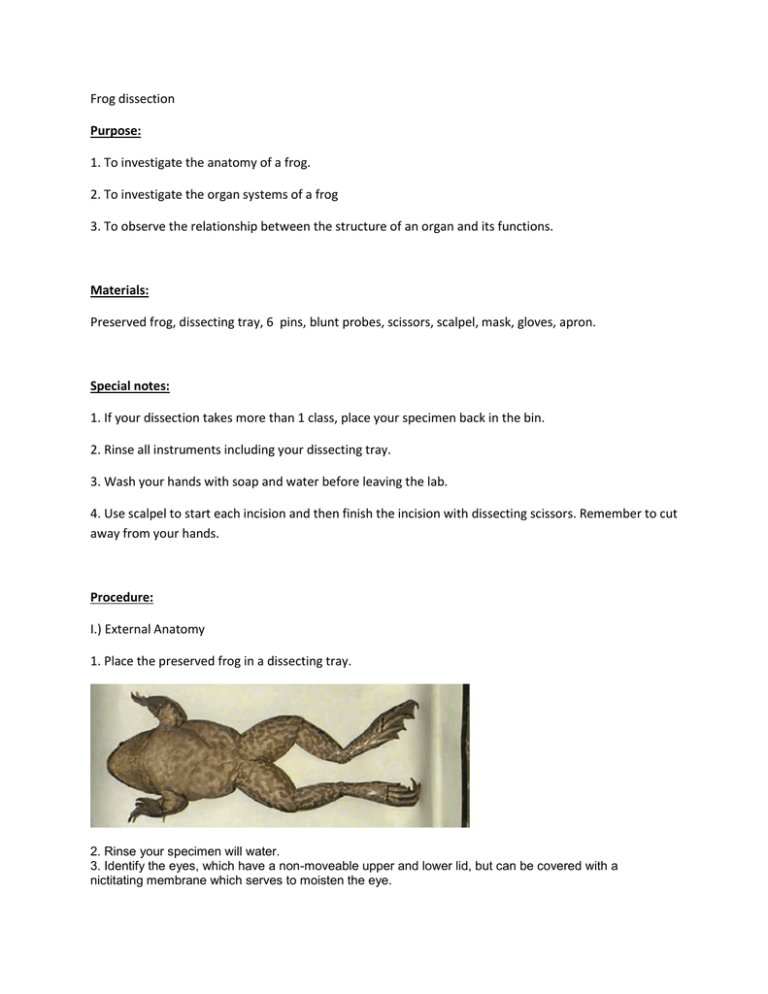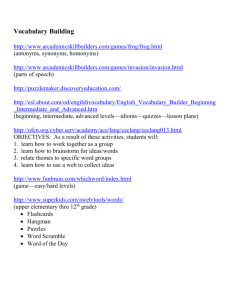Frog Dissection Lab: Anatomy & Organ Systems
advertisement

Frog dissection Purpose: 1. To investigate the anatomy of a frog. 2. To investigate the organ systems of a frog 3. To observe the relationship between the structure of an organ and its functions. Materials: Preserved frog, dissecting tray, 6 pins, blunt probes, scissors, scalpel, mask, gloves, apron. Special notes: 1. If your dissection takes more than 1 class, place your specimen back in the bin. 2. Rinse all instruments including your dissecting tray. 3. Wash your hands with soap and water before leaving the lab. 4. Use scalpel to start each incision and then finish the incision with dissecting scissors. Remember to cut away from your hands. Procedure: I.) External Anatomy 1. Place the preserved frog in a dissecting tray. 2. Rinse your specimen will water. 3. Identify the eyes, which have a non-moveable upper and lower lid, but can be covered with a nictitating membrane which serves to moisten the eye. 4. Locate the tympanum behind each eye. 5. Examine the external nares (nostrils). Insert a probe into the external nares and note that it protrudes from one of the paired small openings, the internal nares inside the mouth cavity. 6. Identify the paired appendages. The short forelimb consist of an upper arm (forearm) and a hand. The hand has four digits and a rudimentary vestigial thumb. The hind limb consists of a thigh, shank, and a foot. The foot has five digits and a rudimentary sixth digit. II.) Mouth Anatomy 1.Open your frog's mouth very wide, cutting the angles of the jaw if necessary. 2. Identify the tongue attached to the lower jaw's anterior end. What is unusual about the attachment of the tongue? What is the advantage of this attachment? 3. Find the Eustachian tube opening into the angle of the jaws. These tubes lead to the ears. Eustachian tubes equalize air pressure in the ears. This ensures proper tightness of the membrane for good hearing. With your probe, follow a Eustachian tube up to the tympanic membrane. Now find the same tympanic membrane from the outside, behind the eye. 4. Examine the maxillary teeth located along the rim of the upper jaw. Another set of teeth, the vomerine teeth, is present just behind the mid portion of the upper jaw. What might be their function? Vomerine teeth are absent in toads. 5. If your frog is a male, locate the openings to vocal sacs in the floor of the lower jaw near the hinge joints. Why do males have vocal sacs? 6. Locate the glottis, a slit through which air passes in and out of the trachea, the short tube from the glottis to the lungs. 7. Identify the esophagus which lies dorsal and posterior to the glottis and leads to the stomach. III.) Setup for the Dissection Preparation: This section explains the steps necessary to prepare your frog for the dissection process. 1. Place Frog in Pan Rinse the frog with water then place it in the dissection pan. The frog should be lying on it's dorsal (back) side with the belly facing up. 2. Pin the Frog Pin the frog for dissection by securing each of the four limbs to the pan. Place the pins through the hands and feet to secure them to the pan. 3. Begin the First Skin Incision Once the legs of the frog are securely pinned to the dissection tray begin the first skin incision by using the forceps to lift the skin midway between the rear legs of the frog. Using the scalpel, make a cut along the center, or midline, of the frog, bisecting it equally. 4. Continue the Skin Incision Continue the skin incision by using the scissors to cut all the way up the frog's body to the neck. Be very careful not to cut too deeply. 5. Make the Leg Incisions Still using the scissors, make horizontal incisions just above the rear legs and between the front legs of the frog. 6. Separate the Skin & Muscle Once you have finished the incisions between the front and rear legs of the frog you need to separate the skin flaps from the muscle below. To do this: Pick up the flap of skin with the forceps, and use a scalpel to help separate the skin from the muscle below. 7. Pin Skin Flaps Once the skin flaps have been cut pin them to the dissection tray using several pins. 8. Begin the First Muscle Incisions This section will describe the procedures for making the incisions through the frog's abdominal muscles. Now that the skin has been removed, begin the abdominal muscle incision by using the forceps to lift the muscle midwy between the rear legs of the frog. Next use the scalpel to start the incision in the direction of the chin. 9. Continue the Muscle Incision Using the scissors, carefully continue the incision up the midline of the frog, but do not cut too deeply as to damage the organs. 10. Turn Scissors Blades This is very important. When you reach a point just below the front legs, turn the scissors blades sideways to cut through the bones in the chest. This should prevent damage to the heart or other internal organs. When your scissors reach a point just below the frog's neck you have cut far enough. 11. Make the Second Muscle Incisions Next, using the scissors, make horizontal incisions through the muscle between both the front legs and above the back legs. 12. Separate Muscle & Organs To finish opening up the frog's body cavity therefore exposing the abdominal region, use the forceps to hold the muscle flaps while separating the muscle from the tissues below with a scalpel. 13. Pin the Muscle Flaps Once the muscle flaps have been separated from the underlying tissue, they must be pinned back. This will allow easy access to the frog's internal organs. 14. Locate the yellow fat bodies and carefully remove them. IV.) Respiratory System and Liver 1. Insert a probe into the glottis, and observe its passage into the trachea. Enlarge the glottis by making short cuts above and below it. When the glottis is spread open, you will see a fold on either side; these are the vocal cords used in croaking. 2. Identify the lungs, two small sacs on either side of the midline and partially hidden under the liver. Trace the path of air from the external nares to the lungs. The lungs are shallow and do not supply enough oxygen to support the frog without help of the skin and mouth lining. 3. Locate the liver, the large, prominent, dark-brown organ in mid ventral portion of trunk. 4. Under the liver, find the gallbladder. V.) Circulatory System 1. Lift the liver gently. Identify the heart, covered by a membranous covering (the pericardium). With forceps, lift the covering, and gently slit it open. Amphibian hearts have 3 chambers. The heart consists of a single, thick-walled ventricle and two (right and left) anterior, thin-walled atria. VI.) Digestive System 1. Identify the esophagus, a very short connection between the mouth and the stomach. Lift the left liver lobe, and identify the stomach, which is whitish and J-shaped. The stomach connects with the esophagus anteriorly and with the small intestine posteriorly. 2. Slit open the side of the stomach, and notice its ribbed internal surface. Try to identify its contents. Remove a short piece of the small intestine, and examine the inner lining through a dissecting microscope. 3. Find the small intestine and the large intestine, which enters the cloaca. The cloaca lies beneath the pubic bone and is a general receptacle for the intestine, the reproductive system, and the urinary system. It opens to the outside by way of the anus. Trace the path of food in the digestive tract from the mouth to the cloaca. 4. As you lift the small intestine you will see the pancreas, a thin, yellowish ribbon, between the small intestine and the stomach. 5. Locate the spleen, a small pea-shaped body near the stomach. It produces new blood cells and disposes of old ones. VII.) Urogential System The urogenital system consists of both the urinary system and the reproductive system. 1. Identify the kidneys, which are long narrow organs lying against the dorsal wall. 2. The bladder is a thin sac attached to the cloaca, it may be difficult to locate. Identify the urinary bladder, attached to the ventral wall of the cloaca. In frogs, urine backs up into the bladder from the cloaca. 3. The light stripe lying on the ventral side of each kidney is the adrenal gland. VIII.) Male Anatomy 1. Locate the testes in the male frog. They are yellow or tan-colored, bean-shaped organs near the anterior end of each kidney. Several small ducts, the vasa efferential, carry sperm into the kidney ducts that also carry urine from the kidneys. Fat bodies, which store fat, are attached to the testes. IX.) Female Anatomy 1. Locate the ovaries in the female frog. They are attached to the dorsal body wall. Fat bodies are attached to the ovaries. Highly coiled oviducts lead to the cloaca. The ostium (opening) of the oviducts is dorsal to the liver. X.) The brain 1. Carefully cut away the skull to expose the brain. Identify the following parts of the brain. medulla oblongata - controls reflexes like breathing and heart rate cerebellum- controls balance and muscle coordination optic lobe - vision centre cerebrum - sensations, movement, behaviour olfactory lobes - smell centre X.) Cleanup 1. Dispose of all frog parts properly in the container marked Animal Waste. Do not leave any of parts in the trash cans or sink. 2. Rinse and dry all equipment used, including the dissecting pan. Name:______________________ Section:_____ Part A: The Head and External Features 1. Adaptation How It Helps Survival eye position external nostrils (nares) vocal sacs nictitating membrane tympanum maxillary and vomerine teeth vestigial thumb eustachian tube tongue Part C: Respiration Part Function Glottis Trachea vocal cords lung The ventricle has thicker, more muscular walls than the atria. Relate this difference in wall structure to the functions of the 2 types of heart chamber. Part D: Digestion List the organs of digestion in order from the esophagus to cloaca. Why is the inside of the stomach folded? How are the relative lengths of the frog's small intestine and large intestine related to their functions? Part E: Other Organs Part Function liver gall bladder spleen Part F: Urogenital system Part kidneys testes ovaries oviducts Function A mature female may have its body cavity full of black and white eggs. The black portion of the egg contains the living embryo. The white portion is yolk, containing stored food. When placed in water the eggs will float with the light side down. What is the advantage of this? If your frog is an immature female, you will find 2 grayish or pinkish ovaries in either side of the abdominal cavity. The testes of the male are in the corresponding positions. Attached to these organs are yellow fat bodies. What is the function of fat bodies? During one mating of frogs, the female lays some 2,000 to 3,000 eggs in water as the male sheds millions of sperm over them. How do these large numbers relate to the frog’s fitness for life in water? Part G – Brain What do the large optic lobes of a frog’s brain suggest? What does the large olfactory lobe of a frog’s brain suggest? Why does a frog have such a small cerebrum?






